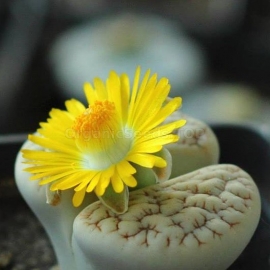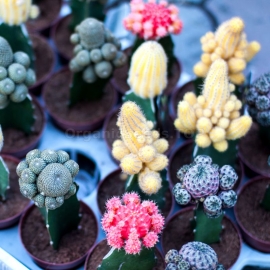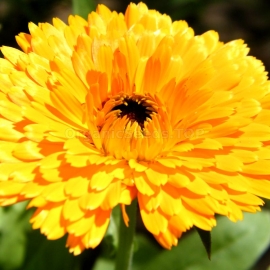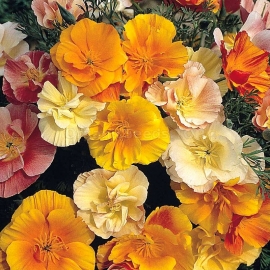


«Venus» - Organic Lithops Seeds (Fulviceps C220)
3.00 €
Small stemless leafy succulents from the Mesembryanthemaceae family, most of the plants are immersed in the soil, the aerial part is two thick leaves fused into a column up to 20-50 mm high.
-
Lithops «Venus» / Lithops Fulviceps C220
These are small stemless leafy succulents from the Mesembryanthemaceae family. Most of the plants are buried in the soil. The aerial part is two thick sheets fused into a column up to 20-50 mm high. Its top is dotted with patterns, conical, convex or flat, divided by a gap, from which a peduncle and new leaves appear.
The change of leaves occurs annually from March to May, while last year's leaves dry up. They bloom in July - November, the flowers are white or yellow (occasionally orange), 2.5 - 3 cm in diameter, sometimes fragrant, open in the afternoon. In July - August, the plants rest.
From September to December, they begin to grow again. In November-December, watering of Lithuanians is reduced and stopped, they are kept at a temperature of 12-15 ° C. In late spring, when a pair of new leaves appears. watering is gradually resumed.
Lithops feed or apply fertilizer for cacti in half concentration. They benefit from spraying in the afternoons on hot summer days.
After a few years, the plants grow into a whole colony, which is transplanted into a container with good drainage. The substrate is made up of leaf earth and sand in equal parts. Demanding on lighting, in the spring they are shaded from bright sunlight.
Basic questions about lithops.
1. In what soil to plant seedlings and seeds.
These plants can grow in any soil mix. The main thing is that the substrate is airy, passes water well and dries quickly. The most optimal earthen substrate for lithops: - 1 part of the earth (leaf earth + turf); - 2 parts perlite, coarse sand 1-2mm, you can add small pebbles 1-3mm At the bottom of the pot, drainage from small pebbles is desirable, you can use dry sphagnum moss, detailed pieces of foam will also work. They also grow well in commercial mixtures: Lechuza pon, ceramis, akadama - but you need to use liquid cactus fertilizers (half the indicated dosage) when watering, about every fourth watering.
2. Planting lithops seeds.
It is better to plant lithops seeds in spring or early autumn (under artificial lighting). You can plant in a plastic transparent container, with a transparent lid, steam the ground before planting, preferably in a water bath for 1-1.5 hours. Simply sprinkle the seeds on top without deepening into the ground, cover with a transparent lid and keep closed for 2 weeks, then, when the seedlings get a little stronger, you can lift the lid on one side to ventilate a little. Water, after opening, as the soil dries, the seedlings should be shiny and resilient.
3. What should be the lighting.
They grow well in any sunny location, ideally a south, southeast, southwest side, it is also possible to keep seedlings under fluorescent lamps or LED lighting. Distance from lamps 10-15cm. In early spring, it is advisable to shade from direct sun until the plants get used to it, in extreme heat it is better to use shading even for adult plants.
4. What should be the temperature of the content.
The ideal temperature is +23C - +27C. In summer, they withstand an increase in t to +45 C, but at the same time they must be in a well-ventilated place. Otherwise, they can get sunburn (heatstroke) and die. In winter, when plants are not watered, they easily tolerate temperatures of + 1C, but the optimum temperature for wintering is + 10-16C, humidity during wintering is preferably not higher than 60%.
5. How to properly water lithops.
The period of watering lithops from the second half of spring to mid-autumn, in the summer when it is very hot, the end of July - August is better not to water. Usually they are watered during this period as the soil dries out, another good indicator is the body of the plant, if wrinkles appear on the side and the plant squats and drips into the ground, then lithops must be watered .. By winter, watering is reduced and from mid-November to the end of March they are not watered at all . Spraying is not necessary, I personally never do this, except for preventive treatments from pests. From about December to early April, this is the time of the so-called “molting”, this is when the plant forms a new young pair of leaves due to old, drying leaves. At this time, the plants are not watered, and kept in the most lit place, for the correct formation of new leaves,
6. Transplant. It is better to transplant adult lithops in winter, during the dormant period, but in spring and summer it can also be transplanted, the main rule when transplanting is to plant in completely dry ground and do not water for 10-15 days. It is not advisable to transplant seedlings before the first molt.
With this product buy
Product code: 2023
1.14 €
A very nice mix of 100+ seeds composed of many different species of cacti and Succulents. You will get 100 seeds or more. You can sow the seeds using your own method.
Product code: 12683
1.14 €
It is an annual plant with a height of 50 to 70 centimeters, this variety produces beautiful large flowers, blooms from June to October, and in some cases, the flowering period can last until November.
Product code: 12684
1.14 €
A spectacular plant with strong peduncles that do not require a garter, and luxurious lush inflorescences of a delicate lilac-lilac color, perfect for decorating flower beds and obtaining high-quality cut.
Product code: 12695
1.14 €
No wildflower garden can be without this California Poppy Mission Bells mix. These California Poppies makes a breathtaking display especially when grown in a mass grouping. Sow the Mission Bell Poppy seeds in the early spring for a great performance.




